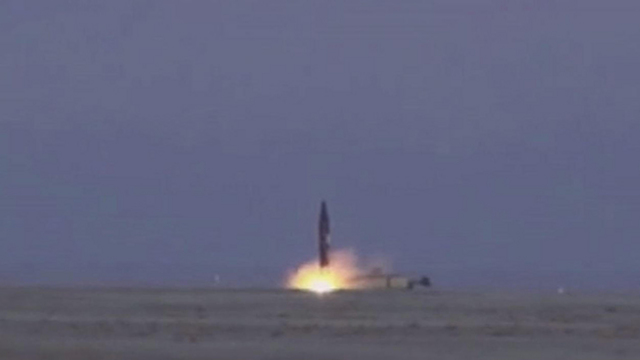
The missile launch. The Iranians are provoking the Americans because they can
Photo: AFP, IRIB TV

Iran missile test: Nuclear deal’s rotten fruit
Analysis: The new ballistic missile Tehran tested is one of the prices Israel is paying for its failed conduct throughout the world powers’ negotiations with Iran, which led to Israel’s exclusion and inability to influence both the open agreement and its concealed and informal clauses.
Why does Iran need a heavy, one-stage, inaccurate missile, with a liquid fuel engine and a huge 1.5-meter warhead that can carry more than 1 ton to a range of 2,000 kilometers? The only logical answer is that the Khorramshahr missiles, which are being developed along with the Shahab missiles, are designed to carry a nuclear warhead. Provided that is the case, accuracy plays a marginal role.
The most advanced models of the Shahab-3 missile, on the other hand, can already reach a range of 1,950 kilometers, according to the Iranians, basically covering every spot in Israel. Their warhead, however, weighs half the Khorramshahr warhead, which explains why the Iranians are developing another family of missiles that would be able to carry nuclear warheads.
The Khorramshahr missile test, which was conducted in Iran in recent months and reported Saturday, is the rotten fruit of the nuclear agreement between Iran and the world powers. To be more exact, it’s one of the prices Israel is paying for its failed conduct throughout the negotiations between the world powers and Iran, which led to its exclusion from talks and the loss of any ability it might've had to influence both the open agreement and its concealed and informal clauses.

Khorramshahr missile test. The Americans clearly approved the Iranians’ red lines (Photo: AFP, IRIB TV)
In 2013, when Iran and the world powers signed the interim agreement, Israeli officials were already aware of the secret side agreement being devised between then-US President Barack Obama’s representatives and the Iranian representatives, and there were already reports the Iranians had received the Americans' permission to keep developing missiles up to a range of 2,000 kilometers. At the same time, the Iranians were already busy developing missiles with longer ranges of 2,500 to 5,000 kilometers, which could reach Europe and the United States. In the secret talks, the Americans restricted them to 2,000 kilometers—the exact effective range to Iran’s main enemy, Israel. And, if one insists, to Saudi Arabia as well.
The Middle East Media Research Institute (MEMRI) quoted Iranian officials openly discussing the understanding reached with the Americans on the missiles. Revolutionary Guards commander Ali Jafari said immediately after the interim agreement that “Iran can produce missiles beyond the 2,000-kilometer range, but we have been restricted by our leader Khamenei. Our missiles must reach Israel. The regime’s red lines were not crossed in the nuclear talks.” The commander of the Revolutionary Guards’ aerospace force admitted as well that “our missiles’ 2,000-kilometer range is intended for a conflict with the Zionist regime.”
Clearly, the Americans approved the Iranians’ red lines—the range to Israel. Today, the Iranians are provoking the Americans because they can. The way the Americans are handling the crisis with North Korea is only encouraging the Iranians to act like hooligans. While the US is threatening to review the nuclear agreement, the Iranians are revealing the missile with the nuclear potential to convey a message: The US should talk to them, rather than work to change the nuclear agreement.
The Khorramshahr is clearly a North Korean missile, reflecting the tight cooperation between the two countries. It is based on a Russian ballistic missile fired from submarines, which was converted into a surface-to-surface missile. In 2005, North Korea transferred 20 of these missiles to Iran. It took the Iranians about a decade to adjust them to their own needs and make them launchable.
Saturday’s reports on the missile test in Iran included information that the missile is capable of carrying three split warheads. If this information is true, this is the first time it is revealed that Iran has a multiple independently targetable missile. Israel should proceed on the assumption that North Korea already provided Syria with nuclear abilities in the reactor that was bombed in 2007. Similarly, it should be assumed that as part of the intimate relations between Iran and North Korea, Iran is enjoying North Korean's cooperation in the nuclear field for a generous payment. Israel should also consider the fact that Iran is now capable of producing a missile carrying a nuclear warhead—single or multiple.
















